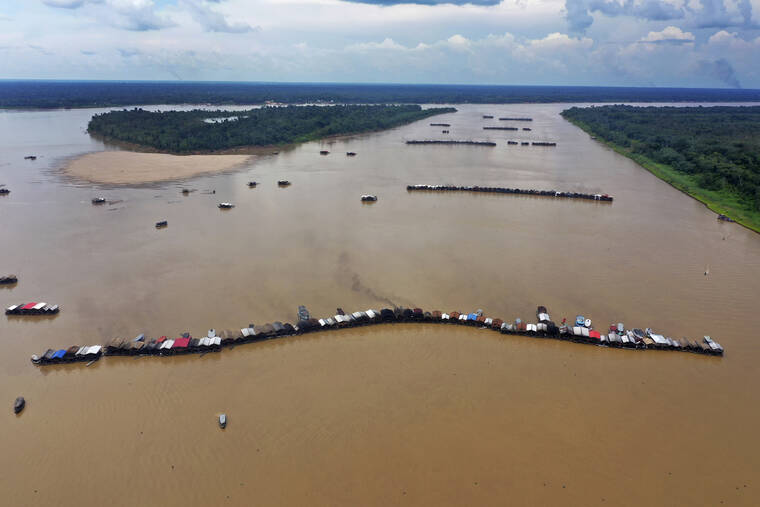ON THE RIO MADEIRA, Brazil — Hundreds of barges of illegal miners dredging for gold were navigating along the Madeira River in the Brazilian Amazon on Friday, and researchers said they posed a threat of pollution — including toxic mercury — for the broader environment.
The barges were spotted this week by the municipality of Autazes, some 70 miles from Manaus, the capital of Amazonas state.
Smaller gatherings of barges are common along rivers in the region, but the latest collection drew international attention this week when Greenpeace and news media published images of several rows of rafts.
Brazilian Vice President Hamilton Mourão announced an imminent police operation in the area, prompting the miners to depart early Friday and head elsewhere along the river.
Miner Thiago Bitencourt Gomes, wearing just a pair of shorts and some flip flops, told The Associated Press on Friday that about 400 barges — some 3,000 people — congregated in the area after one miner found gold there and alerted the others.
“Here everybody knows each other. We’re all friends, we’re all related,” said the 28-year-old whose father, uncles, aunts and cousins were also part of the contingent.
The wood-walled rafts, some equipped with satellite internet and air conditioning units, were tied together, forming rows of houses on the wide and muddy Madeira River, a large tributary that flows into the vast Amazon downstream from Manaus. Miners and their families live, eat and work on the barges, some accompanied by their dogs and other pets.
“We know that in the law, we’re illegal. But we all need to provide for our families,” Gomes said, adding that the miners had repeatedly called on politicians to legalize their activity — in vain.
Another miner said a barge collected about 60 grams of gold — worth roughly $3,500 if pure — over 40 hours of work. Workers often took turns to work 24 hours a day.
Environmentalists are alarmed by the fact miners use mercury to separate gold from the sediment they suck from the river bottom and the process gives off toxic vapors as well as spilling some into the river.
Once in the river, it falls to the bottom and enters the food chain, contaminating fish, shrimp, turtles and other marine life as far as about 300 miles downstream, said Paulo Basta, a researchers at the government’s Fiocruz science center
Basta said there is strong evidence of mercury contamination linked to cognitive problems, alteration of senses and hypertension, and he noted that the miners themselves have high risks of exposure.
“He takes the mercury in his hand, or puts it inside his bag. It leaks, drops on his leg and he gets contaminated through the skin. But the most serious form of contamination is by inhaling mercury vapor, which gets into the lungs,” Basta said.
Miners told the AP they didn’t release mercury, which is expensive, into the water but try to recover and reuse it.

